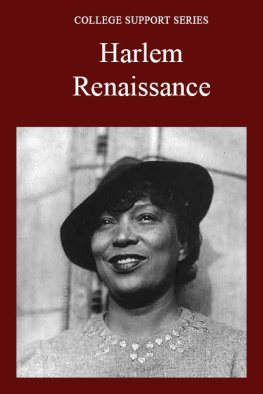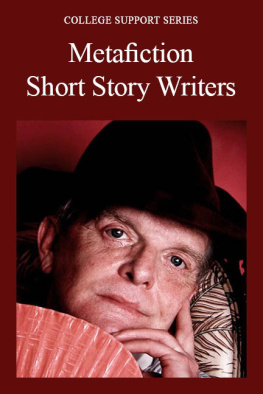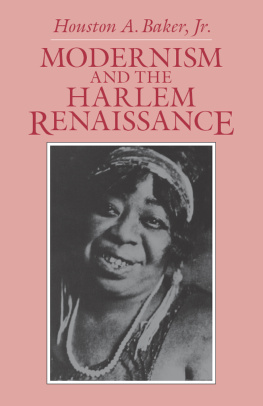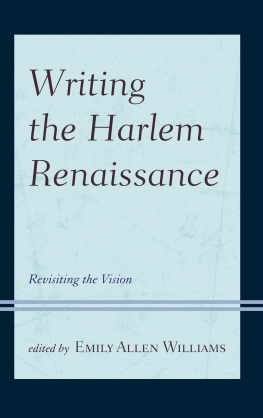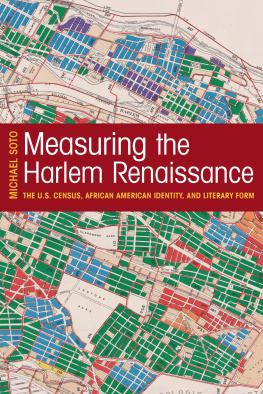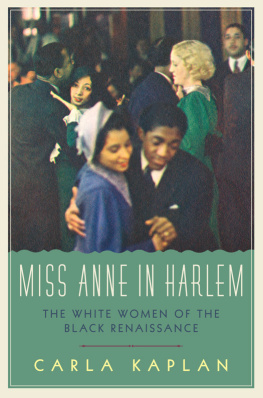The Editors of Salem Press - Harlem Renaissance
Here you can read online The Editors of Salem Press - Harlem Renaissance full text of the book (entire story) in english for free. Download pdf and epub, get meaning, cover and reviews about this ebook. year: 2016, publisher: Salem Press, genre: Detective and thriller. Description of the work, (preface) as well as reviews are available. Best literature library LitArk.com created for fans of good reading and offers a wide selection of genres:
Romance novel
Science fiction
Adventure
Detective
Science
History
Home and family
Prose
Art
Politics
Computer
Non-fiction
Religion
Business
Children
Humor
Choose a favorite category and find really read worthwhile books. Enjoy immersion in the world of imagination, feel the emotions of the characters or learn something new for yourself, make an fascinating discovery.
- Book:Harlem Renaissance
- Author:
- Publisher:Salem Press
- Genre:
- Year:2016
- Rating:3 / 5
- Favourites:Add to favourites
- Your mark:
- 60
- 1
- 2
- 3
- 4
- 5
Harlem Renaissance: summary, description and annotation
We offer to read an annotation, description, summary or preface (depends on what the author of the book "Harlem Renaissance" wrote himself). If you haven't found the necessary information about the book — write in the comments, we will try to find it.
Harlem Renaissance is a single-volume reference that contains biographical essays on the authors followed by two in-depth discussions of specific works. Essays on Ralph Ellisons Invisible Man and Juneteenth are followed by Nella Larsens Passing and Quicksand.
Harlem Renaissance — read online for free the complete book (whole text) full work
Below is the text of the book, divided by pages. System saving the place of the last page read, allows you to conveniently read the book "Harlem Renaissance" online for free, without having to search again every time where you left off. Put a bookmark, and you can go to the page where you finished reading at any time.
Font size:
Interval:
Bookmark:

AFRICAN AMERICAN LONG FICTION
The Harlem Renaissance
The concern with skin color, particularly with miscegenation, became particularly urgent during the Harlem Renaissance (1919-1929), as the possibility of an authentic African American culture began, however tentatively, to take shape. Insofar as the fledgling culture had to partake of the culture of its former oppressors, the tensions and arguments over who and what was, in fact, Negro took on a certain urgency. However, not every African American writer treated this issue with morbid seriousness. Wallace Thurmans Infants of the Spring (1932) is an excoriating roman clef about the central figures of the Harlem Renaissance. Its vicious attacks on the petty prejudices of the leading personages of the day echo themes developed in his first and most popular novel, The Blacker the Berry (1929), which concerns skin-color prejudice within African American culture.
Less known but in many respects a better work, George Schuylers Black No More: Being an Account of the Strange and Wonderful Workings of Science in the Land of the Free, A.D. 1933-1940 (1931) is a hilarious send-up of the obsession with race advancement among members of newly formed organizations such as the National Association for the Advancement of Colored People (NAACP) and the obsession with racial purity among members of the Ku Klux Klan. Thurmans and Schuylers satires on race, class, and gender mock the absurdities of politicians and artists identified with the Harlem Renaissance.
James Weldon Johnsons The Autobiography of an Ex-Coloured Man (1912), for example, represents a logical extension of the reconciliation themes evident in the novels of Harper and Chesnutt. If, in their works, the mulatto or mulatta appears to embody the races best chance for advancement, then passingmulattoes and mulattas disappearing into white societywould obviously be the next logical step. Johnsons novel idealizes the passing motif even as it rehearses its tragedy: the mulatto as a wanderer between separate cultures, never at home in either.
At the opposite end of the spectrum is Nella Larsen. Her two novels, Quicksand (1928) and Passing (1929), contain depictions of the tragic mulatta. In Quicksand , Helga Crane, a mulatta never at ease among African Americans or Caucasians, marries and has children. In Passing , Clare Kendry is a mulatta passing for Caucasian while her friend, Irene Redfield, is both disgusted and envious of her freedom. Kendrys sudden death offers her escape from the humiliation of being unveiled as a nigger by her white, racist husband.
Larsens analyses of middle-class mulattas represents an extension of Jean Toomers Cane (1923), a collage of poetry and fiction centered on multiple themes in early twentieth century African American life: the juxtaposition of urban and rural lifestyles, tensions between the North and the South, and purebred or mixed-blood characteristics. As with Harper, Chesnutt, and others, Toomer links the resolution of these oppositions to the mulatto. Like Larsen, however, Toomer is not optimistic about this figure, who is shunned and scorned by both African Americans and whites.
Between Johnsons idealism and Larsens cynicism lie authors such as Claude McKay and Zora Neale Hurston on one hand and Jessie Redmon Fauset on the other. McKays novel Home to Harlem (1928) was a commercial success, which some critics, including W. E. B. Du Bois, attributed to its exotic treatment of Harlem nightlife. Richard Wright made similar criticisms of Hurstons novel Their Eyes Were Watching God (1937), arguing that Hurston created laughable caricatures of African Americans.
Like the novels of Larsen, Fausets three best novels, There Is Confusion (1924), Plum Bun: A Novel Without a Moral (1928), and The Chinaberry Tree: A Novel of American Life (1931), concern the plight of middle- and upper-class African American women struggling with racial passing, material possessions, marital prospects, and self-worth. Unlike Larsen, and in some respects more like Johnson, Fauset delineates the pitfalls of racial confusion without the melodrama of tragedy. At the same time, Fausets protagonists are clearly more sensitive to, and more psychologically damaged by, the perplexing anxieties of the color caste system in African American culture.
Post-Renaissance realism
If the problem of the color caste system dominated African American fiction as a concern before and during the Great Depression, perhaps it was because of the effects of post-Reconstruction migrations of African Americans from the South to the North. Although writers such as Dunbar attempted to unmask the urban dreamscape, the struggle by so many writers to confront color prejudice among African Americans is linked to the social problems associated with mass migrations: poverty, joblessness, overcrowding, and, in the case of African Americans, class distinctions tied to the presence or absence of white blood. Underlying the tendency to privilege or castigate on the basis of miscegenation was a belief that becoming white was either a way to escape the stigma attached to African blood or a way to delude oneself that white America would accept African Americans if they acted less African.
Richard Wrights groundbreaking first novel, Native Son (1940), changed the terms of the debate, dramatizing the conflict between race and class. Wrights portraits of communiststhe nave Mary, the careless Jan, and the rough-hewn Maxwere augmented by his negative portraits of both liberal Caucasians, such as the Daltons, and African American women, such as Biggers mother, sister, and girlfriend. Wrights realist novel was widely criticized, and in this respect Dunbars equally desolate, if less brutal novel, The Sport of the Gods , can be seen as its most immediate ancestor. A similar combination of gritty realism and broad criticism can be seen in two other writers of the period: Chester Himes and Ann Petry.
Himess postwar work is an effective combination of the hard-boiled detective fiction of Raymond Chandler and the protest fiction of Wright. His best novel, If He Hollers Let Him Go (1945), is a masterful hybrid of these two genres. On one hand, as Wright does in Native Son , Himes compresses his story into a short time frame (four days) that allows him to explore the effects of unrelenting racism on the consciousness of his narrator-protagonist, Bob Jones. At the same time, Himes pays tribute to the detective story as Jones struggles to figure out why a Caucasian coworker has fabricated a rape charge against him. His later novels, such as Retour en Afrique (1964; Cotton Comes to Harlem , 1965), owe more to the detective genre than to the protest novel, perhaps because Himes wrote them after his expatriation to France.
Petrys fame rests primarily on the basis of her novel The Street (1946), the first novel by an African American woman to sell more than one million copies. While some critics have compared the novel to Wrights Native Son because of its intense focus on urban decay and squalor, a case could also be made for linking it to Dunbars The Sport of the Gods and Hurstons pioneering Their Eyes Were Watching God . Just as Hurstons novel concerns Janies triumph over the patriarchal traditions of white male racism and black male chauvinism, so, too, does Petrys novel focus on Lutie Johnsons attempts to eke out a meager living away from the brutality of her father. Like those of the mother in Dunbars novel, Luties dreams to provide for herself and her son are driven by a navet that drags her even further down the social ladder. If Hurstons Janie seems like an idealized role model for all women to emulate, Petrys Lutie is a grim reminder of what so many black women actually go through in their daily lives.
Next pageFont size:
Interval:
Bookmark:
Similar books «Harlem Renaissance»
Look at similar books to Harlem Renaissance. We have selected literature similar in name and meaning in the hope of providing readers with more options to find new, interesting, not yet read works.
Discussion, reviews of the book Harlem Renaissance and just readers' own opinions. Leave your comments, write what you think about the work, its meaning or the main characters. Specify what exactly you liked and what you didn't like, and why you think so.

